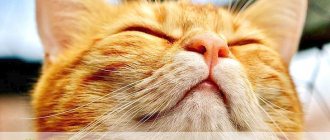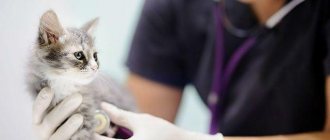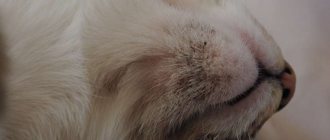Rhinitis is the medical name for a disease that is commonly called a runny nose. And if you think that this phenomenon is typical only for people, then you are mistaken. Cats can also experience a runny nose, and in cats it is often much more severe than in humans. Because of this, rhinitis poses a significant threat to the pet and requires professional, timely and thorough treatment. In this article, the adoption team will talk about the causes of the disease and how to quickly and effectively cope with it.
1) What is rhinitis in cats
2) Causes of rhinitis
3) Symptoms of the disease
4) How is rhinitis treated in cats?
5) Prevention of rhinitis in kittens
Why is rhinitis dangerous for cats?
A runny nose in cats is a common disease, but it is not at all as harmless as some owners believe. A cat's nose is an unusually sensitive instrument, a kind of odor indicator. For this reason, animals can easily figure out where the desired object is, even when it is located at a great distance. Cats' nasal passages are narrow, and swelling caused by inflammation can completely block the nose. A runny nose in a cat is an unpredictable disease. Blocked nasal passages do not cope with their functions of cleaning and warming the air. The animal can only breathe through the mouth; cold air easily penetrates into the lungs. This can provoke hypothermia and an inflammatory process. A cat experiencing oxygen starvation becomes lethargic and lifeless, which leads to exhaustion and dehydration. If you do not treat rhinitis in a cat, it will become chronic, and the life of your pet will turn into sheer agony.
How you can help treat your pet at home
Having received the test results and the doctor’s recommendations for treating your pet, you must begin the prescribed therapy.
Drugs should be given in the quantity and sequence as indicated by the doctor.
To carry out successful therapy at home, the following will have a positive effect:
- attentive attitude towards the animal;
- placing the bed in a warm, quiet place;
- availability of clean and fresh water at room temperature.
Symptoms of rhinitis in cats
There are signs that will tell you that your furry pet is suffering from rhinitis. These include:
- Difficulty breathing. After active actions, running or playing, the animal's breathing becomes heavy. Swollen nasal passages do not allow sufficient oxygen to be received; the cat gasps for air.
- A state of detachment, indifference to everything around. The animal falls into apathy; games, entertainment and treats do not interest him.
- The cat is trying to put its nose in order on its own, scratching the diseased organ with its paw, moving it over furniture and other objects.
- The temperature may rise (up to 39 C), the cat’s nose becomes hot.
- Often a runny nose is accompanied by conjunctivitis, the cat's eyes swell, and pus collects in the corners.
- Nasal discharge.
The types of rhinitis vary, as does nasal discharge. The acute form of a runny nose is characterized by copious clear discharge. When a cat sneezes frequently and endlessly rubs its nose on furniture and other objects, there is reason to think about allergic rhinitis. If the cause of a runny nose is a viral infection, the discharge from the animal's nose will be the color of pus.
When rhinitis is caused by damage to the inner lining of the nose, the discharge is bloody and flows from only one nostril. With any type of rhinitis, crusts of dried discharge are visible under the animal’s nose.
Treatment of cats
Once on the nasal mucosa, the virus penetrates the cells of the body, causing the cells to die. This is how inflammation begins. Also, general deterioration and fever are caused by viruses that have entered the bloodstream.
For the successful recovery of your furry pet, comprehensive treatment and proper care are necessary. The veterinarian will prescribe treatment based on the general condition of the patient. Experts do not recommend taking various medications on your own. This can only worsen the patient's condition.
In addition to taking special medications, the following recommendations will be useful:
- Isolation of a sick animal from healthy ones;
- Mandatory disinfection of the place where the sick pet lies;
- Drink warmly and avoid hypothermia;
- Cleaning the nose and eyes with antiseptics daily;
- If you refuse to eat, you need to force-feed the patient to avoid liver lipidosis (accumulation of fat);
- Gentle, liquid food: fish, meat, cereals and milk;
- The use of vitamin preparations, for example: Gamavit;
- Use of immunostimulating drugs: Imunofan, Fosprenil, Salmozan;
- Complex therapy includes the use of antiviral drugs: Acyclovir, Lysine, Gamapren;
- Antibiotics should be used if there is a manifestation of secondary infections, for example: Flemoxin, Sumamed, Cefazolin.
If you treat your cat correctly and follow all the recommendations of a professional, the animal’s condition will improve in 8-10 days.
The disease rhinotracheitis leads to a decrease in immunity. This leads to various negative consequences:
- The chronic stage is dangerous for the development of pneumonia, intestinal atony, damage to the nervous system, subsequent exacerbations of the disease, and the development of secondary infections;
- An advanced form of the disease can lead to damage to the eyeballs so that they have to be removed;
- In particularly severe cases, the disease leads to the death of the animal. Most of all, this threatens kittens and young individuals due to weak immunity;
- More than 80% of animals remain carriers of the infection after recovery.
Thus, a cat that has had rhinotracheitis is a source of infection for its kittens. The virus infects the animal's uterus. Therefore, miscarriages, various pathologies and deformities in newborns most often occur with infected cats. The virus is excreted in feces and urine for quite a long time, for 1.5 years.
What causes a runny nose in cats?
There are several reasons. They are caused by improper nutrition and care of the animal, arise as a result of infection, or are a concomitant disease with oncology or other serious pathologies.
- Purebred pets often suffer from allergic rhinitis. This is how their body reacts to plant pollen, chemicals, medications, cleaning products, and cosmetics.
- A runny nose can be one of the signs of a serious infectious disease - pneumonia, tuberculosis.
- Rhinitis sometimes appears in an animal after prolonged hypothermia, ingestion of cold food or water.
- Hot air and steam can cause a runny nose. When a cat is near boiling water for a long time, or its fur is dried with a hairdryer, its body may react with acute rhinitis.
- The presence of foreign objects (fluffs, grains of sand) in the nasal passages also causes a runny nose.
- Oncological diseases that are localized in the nasal passages.
Treatment of rhinitis caused by fungi, parasites and allergens
The fungal flora that most often provokes rhinitis is called cryptococcal. To eliminate it, Itraconazole, Fluconazole and other similar drugs are prescribed. The amount of medication depends on the weight of the cat, and the course of treatment is long and lasts at least a month. The first drug is prescribed at a dose of 5 mg per kg once a day. The second medicine must be given to the pet twice a day, 50 mg. The required amount must be dissolved in 1 tsp. boiled water and pour into the animal’s mouth on an empty stomach.
During therapy with antifungal drugs, a cat's appetite may worsen, digestive problems may occur, as well as nausea and vomiting. If such symptoms appear, you should notify your doctor to adjust the dosage.
Fluconazole is active against fungal flora
To eliminate a runny nose caused by parasites, special drops are used on the withers, which can get rid of helminths, as well as fleas, ticks and lice-eaters. Such products should be used once. After 24 hours, all parasites will leave the pet’s body. Drops are applied to the skin, spreading the fur in the withers area. Most often, Dironet, Prazicide, Bars and others are used for treatment. Drops applied to the skin are generally well tolerated. Only occasionally may the pet feel worse and become lethargic.
Dironet gets rid of parasites
If a symptom occurs against the background of an allergy, then it is important to identify the provoking factor and eliminate it. Antihistamines are also used additionally for treatment: Suprastin, Zodak, Tavegil, etc. It should be remembered that these medications do not eliminate allergies, but only relieve symptoms. It is enough to give the animal a quarter of a tablet per day on an empty stomach. The course of treatment should not exceed 7 days. When treated with antihistamines, the pet may appear lethargic, which is caused by a slight sedative effect. After discontinuation of the drugs, the animal’s condition returns to normal.
Tavegil relieves allergy symptoms
It is recommended to provide your pet with rest during treatment. It is important to protect your cat from stress, monitor its diet and prevent hypothermia.
How to rid a cat of a runny nose - video
How to treat a runny nose in a cat
Owners should take the disease seriously. First, you need to show your pet to a veterinarian. The doctor will determine what happened to your pet and prescribe the necessary medicine. Treatment of a runny nose begins with eliminating the underlying cause. If a cat has an infectious disease, an antibiotic, Baytril or Amoxiclav, will help him. When a viral infection occurs, the doctor will prescribe Giscan, Vitafel, Neotime. If we are talking about a fungal disease, you will need the drug "Biopirox". The crusts are removed with a cotton swab soaked in hydrogen peroxide. In case of severe nasal congestion, special drops are used for 7 days to constrict blood vessels. The nose is washed with a solution of boiled salt, after wrapping the pet in a towel. You can warm up the animal's nose with a bag of hot sand. It is quite possible to cure a runny nose in a cat on your own. But at the same time, do not neglect the services of a veterinarian, so as not to miss the onset of a serious illness, to prevent the transition of the acute stage of rhinitis to the chronic stage.
Symptoms
To understand that your cat has some kind of problem, you need to pay attention to the following symptoms:
- Symptoms of viruses: runny nose, snot, suppuration of the eyes, vomiting, loss of appetite, diarrhea, while the general condition of the animal usually suffers. In this case, a doctor's consultation is necessary. Sometimes the presence of the virus in a pet can be fatal, and the time passes by for days.
- When a pet is allergic, symptoms such as nasal congestion, running snot, swollen and purulent eyes, impaired respiratory function, and itching appear.
- Symptoms of polyps and tumors: the animal rubs its nose with its paws, as if something is bothering it. As a result of a tumor, asymmetry and curvature may appear on the muzzle.
- Signs of the presence of a foreign body: the cat shakes its face, sneezes, and produces snot.
Prevention
Measures to prevent the appearance of clear fluid from the nose:
- Water procedures. Hydromassage of the sinuses helps remove accumulated mucus.
- Rinsing the nose with a saline solution prepared at home or using pharmacy sprays “Quix”, “Aqualor”.
- Blowing your nose is a procedure for cleansing the nasal cavity.
- Humidifying the air in the room will protect the nasal mucosa from drying out and swelling.
- Diet therapy - avoidance of spicy foods, seasonings, and whole milk.
- Lubricating the nasal mucosa with “Oxolinic ointment” before each exit during the flu epidemic.
- Rinse your mouth and rinse your nose after every return home.
- Elimination of hypothermia and drafts.
- Multivitamins.
Nasal congestion: how to help your cat
A method to help a cat breathe better, also used by us humans, is to use water vapor to help remove mucus.
Obviously, you should not place your cat's head on a bowl of hot water, as the cat may get burned or scalded if it hits the basin. But it would be enough to prepare a steam bath by turning on the hot water of the shower and allowing the cat to enter the steamy environment for 10 minutes, keeping it away from the water.
Additionally, although the cat's nose is blocked, it is necessary to clear it by soaking a cotton swab and running it under the cat's nose. Finally, you need to contact your veterinarian, who will decide whether to subject your furry friend to antibacterial therapy or prescribe a mucolytic drug.
Symptoms of the disease
With rhinitis, the nasal mucosa in kittens becomes inflamed and characteristic discharge appears. They can be unilateral or bilateral, purulent or mucous, have an unpleasant odor or contain particles of blood. All this depends on the cause of the disease and its neglect.
Doctors have identified symptoms that can be observed in cats during rhinitis:
- difficult and intermittent breathing;
— it is difficult for a pet to play active games;
- fatigue, drowsiness, apathy;
- loss of appetite;
- itching in the nose area, constant desire to scratch it, rub it;
— the cat begins to sneeze;
- cough appears;
- nose is dry and hot (fever);
- pus from the eyes (the eyes themselves become slightly swollen);
- mucus from the nose.
The most dangerous manifestation of rhinitis is purulent discharge from the animal’s nose, which indicates an advanced stage of the disease. But you shouldn’t think that only with purulent discharge you should see a doctor. Any of the above symptoms is a reason to take action.










